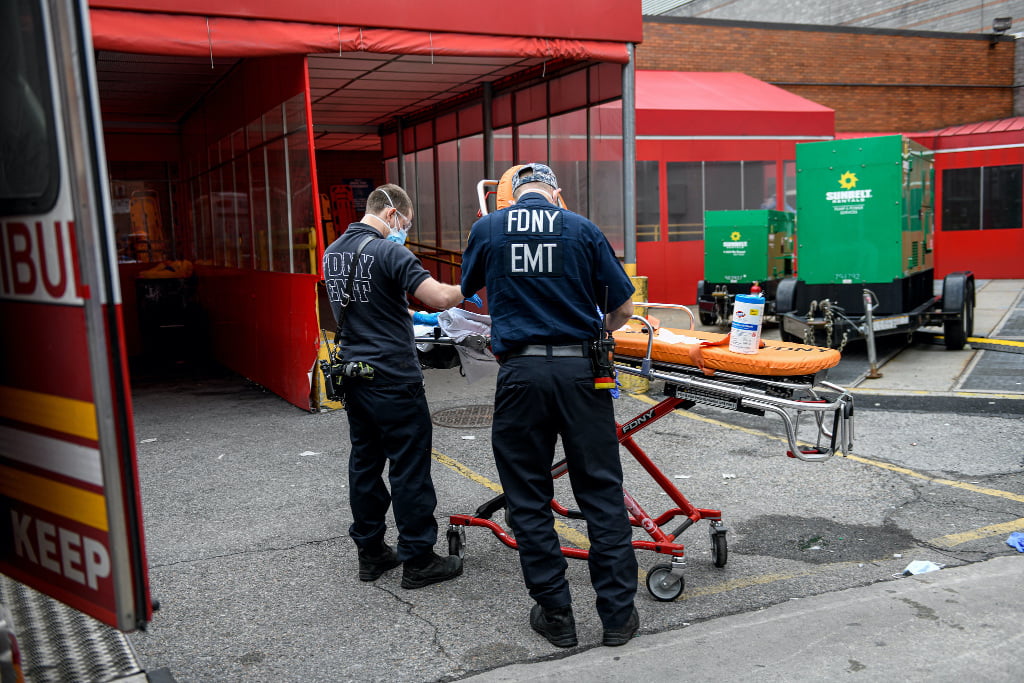
This article focuses on prehospital oxygen delivery strategies for COVID-19 patients. (Photo/FDNY)
COVID-19 and ARDS
Patients suffering from infection with SARS-CoV-2 are particularly prone to the development of serious respiratory complications. Among those who progress from viral infection to COVID-19 pneumonia with acute respiratory distress syndrome (ARDS), risk factors include age, underlying respiratory and cardiac medical comorbidities as well as numerous other under-investigated risk factors.1,2 In the prehospital and emergency setting, many of these patients with severe COVID-19 pneumonia present with severe hypoxemic respiratory failure with peripheral oxygen saturations at dangerously low levels which require emergent intervention. While providing oxygen either through a nasal cannula or non-rebreather will likely be sufficient for most cases requiring transport, other cases will require advanced interventions which are the topic of discussion here.
Classic ARDS represents a spectrum of disease, characterized by a series of causes, as well as variable severity and management.3,4 It is unclear whether COVID-19 is exclusively within this disease spectrum, or represents a distinct entity, as currently there are two phenotypes of COVID-19 pneumonia generally recognized.5 A proposed Type L (type 1) disease is characterized by relatively preserved pulmonary compliance, with hypoxia resulting from a perturbation in pulmonary vasoconstriction that usually occurs in hypoxia, leading to increased pulmonary blood flow and resultant right-to-left shunting;6 as there is a limited extent of non-aerated tissue on imaging, this type would not benefit from lung recruitment by higher positive end expiratory pressure (PEEP). In Type H (type 2), a more classic picture of severe ARDS is seen, with reduced pulmonary compliance along with severe hypoxia and findings of bilateral edema on imaging with much more dense lungs; in these instances a higher PEEP strategy may be employed.7 Other characteristics of SARS-CoV-2 infection and COVID-19 include direct endothelial involvement and inflammation,8 diffuse microthrombi, and lung fibrosis,9 all of which contribute to the spectrum of disease seen, as well as the complexity in management.
Proning Strategies
In severe ARDS, early and prolonged prone positioning has been shown to reduce mortality,10 and is a widely employed practice in intensive care units during the COVID-19 pandemic. This concept has previously been applied to other patients with ARDS and noted to improve PaO2 to FiO2 ratios when used with high flow nasal cannula (HFNC) and noninvasive ventilation (NIV),11 however was not appropriate for patients with severe ARDS (mechanical ventilation was required). Prone positioning has been applied to patient’s with COVID-19 with mild to moderate ARDS who are breathing spontaneously or are requiring NIV. Small studies had shown a positive impact, including increases in PaO2 both when breathing spontaneously12 and with NIV. However, not all patients tolerate the prone position, and that those who do may also revert to prior oxygenation levels once returned to supine. This tactic has not been confirmed in larger trials, but its use may be employed in the prehospital setting in order to support patients’ oxygenation, even if transiently, en route to a hospital setting where invasive ventilation with prolonged proning would be available.
Intubation in the Prehospital Setting
Patient’s may present as profoundly more hypoxic than their symptoms suggest,13 and noninvasive ventilation options with self-proning may prove insufficient, along with other factors that would warrant intubation in the prehospital setting. In these instances, several unique challenges likely present themselves. In many cases, intubations in the field are unable to be performed in a well-ventilated space and certainly are unable to be performed in a negative pressure room. Taken together, this increases the risk for aerosolization of the virus during intubation both for providers who are intubating as well as the rest of the care team who may not be adequately protected. In addition, after intubation and depending on phenotype, some COVID-19 patients may require significant levels of ventilator support – including high PEEP and FiO2 – which may be beyond the capability of transport ventilators or handheld BVM’s to sustain throughout transport.
If the prehospital team does decide to intubate, some specific prehospital factors should be considered. First, the team and any potential bystanders should be protected from the aerosol generated during the procedure. Team members should, wherever possible, increase ventilation to the space where the intubation is occurring, wear maximum provided PPE, and close all doors (within reason and without limiting ventilation) to minimize the risk of contamination outside of the intubation space. All team members not strictly needed for the care of the patient during and post intubation should leave the intubation area to prevent exposure to aerosol. Second, the team should be prepared for post-intubation ventilator support with high PEEP and oxygen requirements. Even for providers accustomed to high PEEP delivery, COVID-19 pneumonia patients may require higher PEEP than normal to maintain oxygenation. Similarly, if a transport ventilator is used, a lung protective low tidal volume strategy of 6-8cc/kg of ideal body weight should be implemented.
COVID-19 and Basic Principles
As the pandemic evolves, strategies surrounding optimal care for patients are likely to continue evolving. While new information is constantly being discovered, many of the core principles at play in the care of COVID-19 patients remain the same as they have always been – stay safe with maximal PPE, support patients with hypoxemic respiratory failure with as much oxygen as they need, including intubation if absolutely required, and remain cognizant of the continuously evolving nature of the pandemic.
References
- Arentz M, Yim E, Klaff L, et al. Characteristics and Outcomes of 21 Critically Ill Patients With COVID-19 in Washington State. JAMA : the journal of the American Medical Association. 2020.
- Liu K, Fang YY, Deng Y, et al. Clinical characteristics of novel coronavirus cases in tertiary hospitals in Hubei Province. Chin Med J (Engl). 2020;133(9):1025-1031.
- Bellani G, Laffey JG, Pham T, et al. Epidemiology, Patterns of Care, and Mortality for Patients With Acute Respiratory Distress Syndrome in Intensive Care Units in 50 Countries. JAMA. 2016;315(8):788-800.
- Force ADT, Ranieri VM, Rubenfeld GD, et al. Acute respiratory distress syndrome: the Berlin Definition. JAMA. 2012;307(23):2526-2533.
- Gattinoni L, Chiumello D, Caironi P, et al. COVID-19 pneumonia: different respiratory treatments for different phenotypes? Intensive Care Medicine. 2020;46(6):1099-1102.
- Mahjoub Y, Rodenstein DO, Jounieaux V. Severe Covid-19 disease: rather AVDS than ARDS? Crit Care. 2020;24(1):327.
- Gattinoni L, Chiumello D, Rossi S. COVID-19 pneumonia: ARDS or not? Crit Care. 2020;24(1):154.
- Varga Z, Flammer AJ, Steiger P, et al. Endothelial cell infection and endotheliitis in COVID-19. Lancet. 2020;395(10234):1417-1418.
- Copin MC, Parmentier E, Duburcq T, et al. Time to consider histologic pattern of lung injury to treat critically ill patients with COVID-19 infection. Intensive Care Med. 2020;46(6):1124-1126.
- Guerin C, Reignier J, Richard JC, et al. Prone positioning in severe acute respiratory distress syndrome. N Engl J Med. 2013;368(23):2159-2168.
- Ding L, Wang L, Ma W, He H. Efficacy and safety of early prone positioning combined with HFNC or NIV in moderate to severe ARDS: a multi-center prospective cohort study. Crit Care. 2020;24(1):28.
- Telias I, Katira BH, Brochard L. Is the Prone Position Helpful During Spontaneous Breathing in Patients With COVID-19? JAMA. 2020.
- Wilkerson RG, Adler JD, Shah NG, Brown R. Silent hypoxia: A harbinger of clinical deterioration in patients with COVID-19. Am J Emerg Med. 2020.
Aidan Milner, MD, worked as an EMT while in high school and college before studying medicine. Now he is an internal medicine resident at Yale New Haven Hospital, and plans to pursue a career in cardiology with a focus on critical care.
Peter Kahn, MD, MPH, NREMT, is an internal medicine resident at the Yale School of Medicine/Yale New Haven Hospital. His work focuses on public health and policy, with a particular interest in prehospital critical care.



